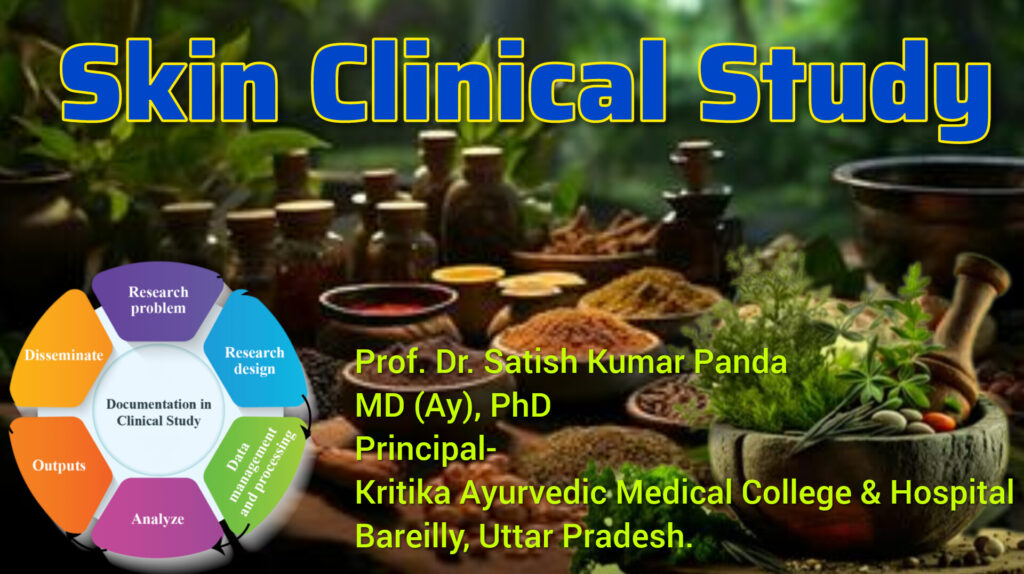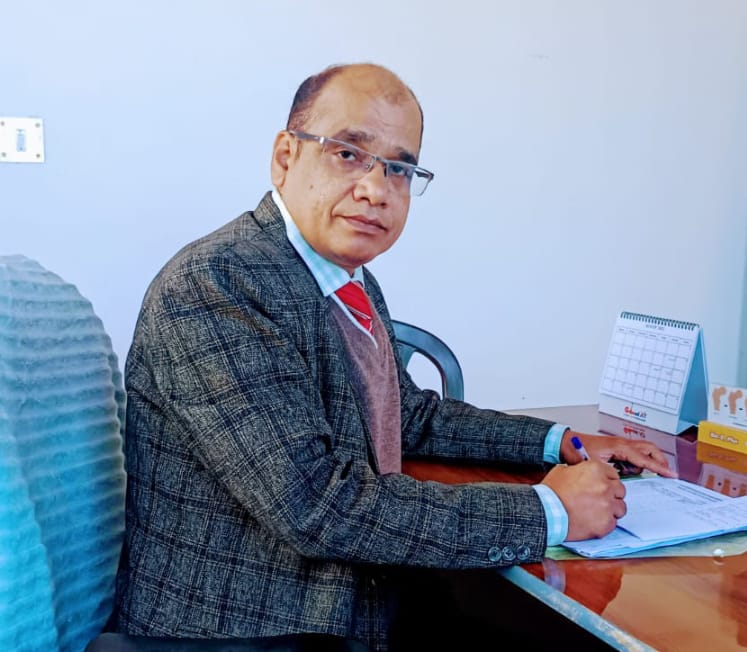

Prepared by: Prof. Dr. Satish Kumar Panda, MD (Ay), PhD
Designation: Principal, Kritika Ayurvedic Medical College & Hospital, Bareilly, Uttar Pradesh.
Date: 19 july 2025
Patient Details
- Name: Mr. Prem Shankar
- Age: 45 years
- Gender: Male
- Occupation: Farmer
- Address: Bareilly, Uttar Pradesh
- Date of Examination: 19 july 2025
Chief Complaints (Pradhan Sampratyatmaka Lakshana)
- Itching (Kandu) – Since 6 months, worse at night
- Scaling of skin (Rookshata) – Prominent on arms and legs
- Discoloration (Vaivarnya) – Blackish-reddish patches
- Burning sensation (Daha) – Mild, aggravated by sun exposure
- Oozing (Srava) – Occasional, from cracked skin
- Pain (Vedana) – Mild, worsens on scratching
History of Present Illness (Poorva Vedana)
- Started 6 months ago with small red patches on arms.
- Gradually spread to legs and back.
- Itching worsened with sweating and dust exposure.
- Skin became dry, scaly, with occasional discharge.
- No prior history of similar illness.
Past Medical History (Poorva Vyadhi)
- Chronic digestive issues (indigestion, bloating) for 2 years.
- No diabetes, hypertension, or tuberculosis.
Family History (Kutumba Anuvanshika Vyadhi)
- No family history of Kushta Roga or chronic skin diseases.
Dietary & Lifestyle History (Ahara & Vihara)
Dietary Habits:
- Frequent intake of fish with curd (Viruddhahara).
- Excessive sweets, dairy, spicy, and oily foods.
Lifestyle:
- Prolonged sun exposure (farmer).
- Poor hygiene, irregular bathing.
- Late-night sleep, disturbed sleep cycle.
Nidan Panchaka (Ayurvedic Etiopathogenesis)
1. Nidana (Causative Factors)
- Viruddhahara (Fish + Curd)
- Excessive Madhura & Snigdha Ahara (sweet, oily foods)
- Poor hygiene, dust/chemical exposure
2. Dosha Involvement
- Kapha-Pitta Pradhana Kushta (due to itching, oozing, burning, discoloration)
3. Dushya (Affected Tissues)
- Twak (Skin), Rakta (Blood), Lasika (Lymph), Mamsa (Muscle)
4. Srotas Affected
- Rasavaha, Raktavaha Srotas (Lymphatic & Blood circulation)
5. Rogamarga (Disease Pathway)
- Bahya (External manifestation)
Dashavidha & Ashta Sthana Pariksha (Examination Findings)
Dashavidha Pariksha (Tenfold Examination)
- Prakriti: Kapha-Pitta dominance
- Vikriti: Kushta Roga (Twak & Rakta Dushti)
- Sara: Moderate Dhatu quality
- Samhanana: Medium build
- Pramana: Normal proportions
- Satmya: Mixed diet tolerance
- Sattva: Moderate mental strength
- Aharashakti: Mild indigestion
- Vyayamashakti: Moderate exercise tolerance
- Vaya: Madhyama Vaya (middle age)
Ashta Sthana Pariksha (Eightfold Examination)
- Nadi (Pulse): Kapha-Pitta (moderate, slightly heavy)
- Mala (Stool): Occasionally hard, incomplete evacuation
- Mutra (Urine): Slightly yellowish
- Jihva (Tongue): Coated white (Kapha)
- Shabda (Voice): Normal
- Sparsha (Touch): Rough, dry skin
- Drik (Eyes): Mild conjunctival congestion
- Akruti (Body Structure): Moderate build
Differential Diagnosis (Vyadhi Vinischaya)
- Vicharchika (Eczema) – Due to scaling, itching, oozing
- Dadru (Ringworm) – Ruled out (no annular lesions)
- Kitibha (Psoriasis-like disorder) – Possible due to rough, scaly skin
Ayurvedic Treatment Plan (Chikitsa)
1. Shodhana Chikitsa (Purification Therapy)
- Virechana (Purgation) – Trivrit Churna (Pitta-Kapha balancing)
- Raktamokshana (Bloodletting) – For Rakta Dushti
- Lepa (External Application) – Nimba Taila, Arka Taila
2. Shamana Chikitsa (Palliative Treatment)
Internal Medicines:
- Khadirarishta (Blood purifier)
- Manjisthadi Kwath (Pitta-Rakta Shodhana)
- Arogyavardhini Vati (Liver detox)
3. Pathya-Apathya (Diet & Lifestyle)
Do’s (Pathya):
- Bitter/astringent foods (Neem, Turmeric, Manjistha)
- Herbal decoctions (Guduchi, Nimba Kwath)
- Maintain hygiene, avoid sun exposure
Don’ts (Apathya):
- ❌ Fish + dairy combination
- ❌ Excess sweets, fermented foods
- ❌ Irregular sleep
Prognosis (Sadhya-Asadhyata)
- Sadhya (Curable) – If treated early with Shodhana & Shamana
- Kruchra Sadhya (Difficult to cure) – If chronic with lifestyle issues
Follow-Up Plan
- After 15 days – Monitor itching, scaling
- After 1 month – Assess improvement, modify treatment
- After 3 months – Long-term maintenance
Conclusion
This case of Kapha-Pitta Kushta Roga (likely Vicharchika/eczema) requires a combination of Shodhana (detox), Shamana (palliative care), and strict Pathya-Apathya for effective management. Early intervention improves prognosis.
